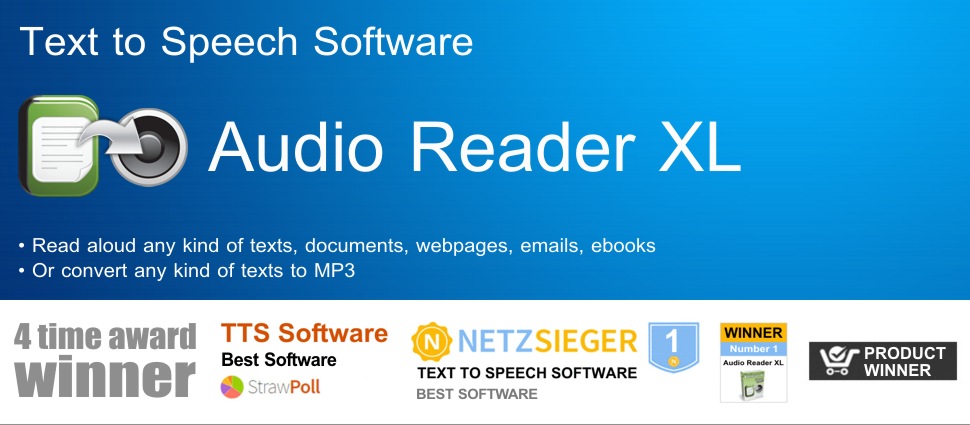Our text-to-speech reader, also referred to as Text-to-Speech software (TTS), is an innovative application that enables computers to convert written text into spoken words.
In recent years, this technology has made significant advances, offering numerous benefits across various application areas. In this guide, we will delve into the workings and diverse applications of the text-to-speech reader.
A text-to-speech reader for the computer is an application designed to transform written text into natural human language. The fundamental idea behind our program is to make the PC sound like it’s speaking, significantly enhancing communication and access to information for individuals with various needs and in different environments.
The text that a text-to-speech reader reproduces can vary, from eBooks and articles to website content and emails. This software can handle a variety of text types and produce output in comprehensible and natural language. This allows people to listen to texts instead of reading them, which is especially beneficial for those who have difficulty reading or comprehending text.
The text-to-speech reader with SAPI support for optimal speech output
One of the helpful technologies utilized by the text-to-speech reader is SAPI support, ensuring optimal speech output.
SAPI stands for “Speech Application Programming Interface,” which is an interface that allows software developers to access and integrate text-to-speech engines into their applications. This integration enables a text-to-speech reader to generate a more natural and human-like voice.
SAPI support also allows a text-to-speech reader to access resources such as voice databases and accents to further refine the quality of speech output. This enables a reading program to simulate various accents and speech styles, which is particularly essential when it is used for different purposes and target audiences.
Another advantage of SAPI support is the ability to adjust speech speed and tone. This allows users to customize the output according to their individual preferences, ensuring that the generated text is read in a manner that is pleasant for them.
Main Features of the Text-to-Speech Reader:
- Converts text into speech with a natural voice.
- Installation is easy, and the text-to-speech reader is self-explanatory.
- Utilizes advanced speech synthesis to generate natural voices.
- Can process various text documents and eBook formats.
- Can read emails, convert eBooks into audio files, and much more.
Advantages of the Text-to-Speech Reader:
- Enhances accessibility for individuals with visual impairments.
- Increases productivity by allowing texts to be “listened to” while performing other tasks.
- Listening to texts can enhance comprehension.
- Can be used for various applications, from emails to eBooks.
- Helps users relax while texts are being read aloud.
Disadvantages of the Text-to-Speech Reader:
- Available only for Windows.
Converting Text to Speech with the Text-to-Speech Reader
The primary function of a text-to-speech reader is to have text read aloud in a natural-sounding voice.
This process begins with the conversion of written text into digital data that can be processed by the software. This data is then sent to the text-to-speech engine responsible for generating the speech output.
The text-to-speech engine interprets the text and uses complex algorithms and linguistic rules to produce a natural human voice. This process includes considering sentence stress, pauses, and intonations to ensure that the output sounds fluent and comprehensible.
Another fundamental aspect of text-to-speech conversion is the quality of speech output. Modern text-to-speech readers use excellent voices that resemble human voices and provide clear and understandable pronunciation. This is especially essential when a text-to-speech reader is used in educational institutions, corporate environments, or healthcare settings where precise communication is essential.
The applications of a text-to-speech reader are diverse. It is commonly used in educational institutions to facilitate access to learning materials for students with reading difficulties or visual impairments. Furthermore, it is used in accessibility technology to ensure that people with visual impairments or reading disabilities can access modern content.
In corporate environments, a TTS program can help increase efficiency by assisting employees in processing text more quickly, whether reviewing documents or conducting training. Additionally, it is used in healthcare to make patient information more accessible and improve the accuracy of reporting.
Our Text-to-Speech Reader: The Innovative Solution for Reading Texts Aloud
Our text-to-speech reader is a valuable solution for converting texts into speech, improving the flow of information, and facilitating communication in various domains. With SAPI technology support and excellent voices, it can generate natural and understandable speech output, benefiting both individual users and business applications.
Good Text-to-Speech Readers Include:
- Audio Reader XL: Easy to install and user-friendly.
- Balabolka: A free option with high customizability and numerous voices.
- Voice Dream Reader: Ideal for listening to eBooks on the go.
- Google Text-to-Speech: An integrated feature on Android devices.
- Natural Reader: Features natural-sounding voices and an excellent interface.
- ReadSpeaker: A versatile program suitable for various applications.
- Kurzweil 3000: A comprehensive text-to-speech reader with numerous features.
- VoiceOver: An integrated program feature on Apple devices for accessibility.

